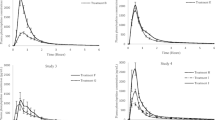Summary
Many drugs have been found to increase or decrease the clearance of theophylline, probably by interaction with one or more of the variants of the cytochrome P450 drugmetabolising system. Theophylline may be particularly susceptible to alteration of its clearance because of the particular form(s) of the P450 system involved, because its metabolism is saturable, and/or because 90% of its elimination is via metabolism. Its clearance has been found to be decreased (typically by around 25%, but often by far more) by erythromycin, troleandomycin (triacetyloleandomycin), roxithromycin, enoxacin, ciprofloxacin, Pefloxacin, norfloxacin, ofloxacin, fluoroquinolone T-3262, pipemidic acid, Cimetidine, etintidine, propranolol, verapamil, diltiazem, nifedipine, furosemide (frusemide), at least some anovulent agents, viloxazine, allopurinol, ticlopidine, idrocilamide, thiabendazole, disulfiram, influenza- and BCG-vaccination, interferon, and caffeine (half-life increase). In contrast, theophylline clearance (clearance/bioavailability) was found to be increased by isoprenaline (isoproterenol), terbutaline, some corticosteroids, Phenytoin, phenobarbital, activated charcoal, felodipine moricizine, benzodiazepines and sulfinpyrazone — typically by about 25%, but sometimes by as much as 80% or more. For several of these concomitant medications, however, only some of the published studies can substantiate an influence, which may highlight the sensitivity of some interactions to particular experimental and/or clinical conditions, e.g. with terbutaline, erythromycin, ciprofloxacin, norfloxacin, ofloxacin, phenobarbital. Cimetidine, verapamil, diltiazem, nifedipine, anovulents, allopurinol and influenza vaccination. Moreover, reports both of inhibition and of induction of theophylline clearance by each of rifampicin and isoniazid have appeared. Nevertheless, under investigation many medications have not been found to perceptibly influence theophylline disposition kinetics, e.g. ephedrine, orciprenaline (metaproterenol), prednisone, prednisolone, temelastine, terfenadine, mequitazine, pi-cumast, repirinast, josamycin, midecamycin, miocamycin, spiramycin, amoxicillin, am-picillin, cefalexin, cefaclor, Ceftibuten, cotrimoxazole (trimethoprim plus sulfamethoxazole), tetracycline, doxycycline, lomefloxacin, fluoroquinolones NY-198 and AM-833, nalidixic acid, lincomycin, metronidazole, certain antacids, ranitidine, roxatidine, piren-zepine, rioprostil, metoclopramide, meloprolol, atenolol, nadolol, medroxyprogesterone, dextropropoxyphene (propoxyphene). Piroxicam, ozagrel, mebendazole and ascorbic acid. Because theophylline has such a narrow therapeutic concentration range, changes in clearance of approximately 25% or more can have clinical impact. For patients requiring medication concomitant with theophylline, therefore, careful choices among alternative therapies, adjustment of the theophylline dosing regimen, and/or therapeutic drug monitoring may be advisable.
Similar content being viewed by others
Author information
Authors and Affiliations
Additional information
A complete reference list will appear in Pt II of this article in the next issue of the Journal.
Rights and permissions
About this article
Cite this article
Upton, R.A. Pharmacokinetic Interactions Between Theophylline and Other Medication (Part I). Clin Pharmacokinet 20, 66–80 (1991). https://doi.org/10.2165/00003088-199120010-00005
Published:
Issue Date:
DOI: https://doi.org/10.2165/00003088-199120010-00005




